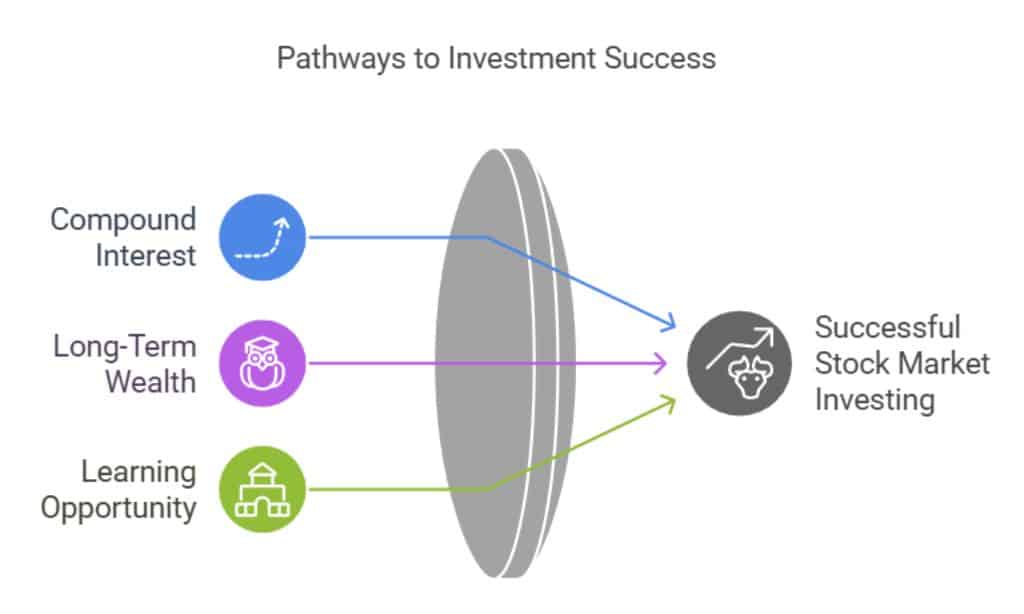Investing in the stock market is one of the most powerful ways to build wealth, especially for young investors. Starting early allows you to take full advantage of compound interest, gain valuable experience, and establish a strong financial foundation.
This guide outlines 12 proven stock market strategies for young investors in 2025, offering actionable insights to help you make informed decisions and maximize returns.
Whether you’re new to investing or looking to refine your approach, these stock market strategies for young investors are designed to empower your financial journey.
Understanding the Basics of Stock Market Investing
Starting early in the stock market gives young investors a significant advantage.
Here’s why:
- Compound Interest: Investments grow exponentially over time as you earn returns on both your principal and previously earned interest. For example, investing $5,000 at 8% annual growth will turn into over $50,000 in 30 years without additional contributions.
- Long-Term Wealth: By starting young, you have decades to accumulate wealth and ride out market volatility. The earlier you invest, the more you can capitalize on market cycles and recover from downturns.
- Learning Opportunity: Early investing allows you to make mistakes and learn valuable lessons without jeopardizing significant assets. For instance, experimenting with small investments in various sectors can help you discover your risk tolerance and preferences.
Key Stock Market Terminology for Beginners
Understanding basic terminology is essential for young investors and lays the groundwork for effectively implementing stock market strategies for young investors:
| Term | Definition |
| Stock | A share representing ownership in a company. |
| Dividend | A portion of a company’s earnings distributed to shareholders. |
| Market Cap | The total value of a company’s outstanding shares. |
| P/E Ratio | A measure of a company’s stock price relative to its earnings per share. |
| Bull Market | A market condition where prices are rising or expected to rise. |
| Bear Market | A market condition where prices are falling or expected to fall. |
Familiarizing yourself with these terms helps you navigate the market confidently and make informed decisions as you apply these stock market strategies for young investors effectively.
Risk vs. Reward in Stock Investing
Balancing risk and reward is key to successful investing:
| Investment Type | Risk Level | Potential Returns | Example |
| Growth Stocks | High | High | Emerging tech companies |
| Index Funds | Low | Moderate | S&P 500 index |
| Bonds | Low | Low | Government treasury bonds |
| Startups | Very High | Very High | Pre-IPO investments in new firms |
- High-Risk Investments: Growth stocks, startups, and emerging markets offer high potential returns but come with significant volatility. For example, investing in a new AI startup could yield massive returns but also poses a risk of total loss.
- Low-Risk Investments: Bonds, index funds, and blue-chip stocks provide stability and predictable returns. These are ideal for those looking to preserve capital while earning steady growth.
- Finding Your Balance: Assess your risk tolerance and diversify your portfolio to match your financial goals. Use tools like risk assessment calculators to determine the best allocation for your circumstances.
12 Stock Market Strategies for Young Investors in 2025
Here are the pro strategies that all young investors must follow.
Strategy 1 – Start with Index Funds or ETFs
Why Index Funds Are Ideal for Beginners
Index funds and ETFs provide:
- Diversification: Spread your investment across various sectors, reducing the impact of poor performance in any single industry.
- Low Costs: Minimal management fees compared to actively managed funds. Many funds, like the Vanguard Total Stock Market ETF, have expense ratios as low as 0.03%.
- Simplicity: Easy to buy and hold without constant monitoring, making them perfect for those starting their investment journey.
| Index Fund/ETF | Expense Ratio | Average Annual Return | Risk Level |
| S&P 500 ETF | 0.03% | 10% | Low |
| NASDAQ 100 ETF | 0.20% | 12% | Moderate |
| Total Market ETF | 0.07% | 9.5% | Low |
Example: Investing in the S&P 500 index offers exposure to 500 leading companies, giving you instant diversification across a wide array of industries. For many young investors, this forms the cornerstone of successful stock market strategies for young investors.
Strategy 2 – Diversify Your Portfolio
Balancing Sectors and Industries
Diversification reduces risk by investing in different sectors:
| Sector | Example Companies | Key Trends |
| Technology | Apple, Microsoft | AI, cloud computing |
| Healthcare | Pfizer, Moderna | Biotech and telemedicine |
| Consumer Goods | Coca-Cola, Procter & Gamble | Sustainable products |
| Energy | ExxonMobil, Tesla | Renewable energy growth |
| Financials | JPMorgan, Visa | Digital banking and fintech |
- Avoid over-reliance on a single industry. For instance, during the COVID-19 pandemic, technology stocks soared while travel stocks plummeted.
- Practical Tip: Use online portfolio trackers to monitor and rebalance your investments periodically.
This approach ensures your stock market strategies for young investors stay robust and effective even during economic uncertainties.
Strategy 3 – Invest in Growth Stocks
Identifying High-Growth Companies
Growth stocks are companies expected to grow faster than the market average.
Look for:
- Strong Revenue Growth: Consistent year-over-year increases.
- Innovative Products or Services: Companies disrupting traditional industries.
- Market Trends: Aligning with current economic shifts. For instance, companies in the renewable energy or EV sectors are poised for significant growth.
Case Study: A $5,000 investment in Amazon in 2005 would be worth over $500,000 today due to its consistent growth and market dominance. Growth stocks are a vital part of stock market strategies for young investors seeking high returns.
Strategy 4 – Reinvest Dividends
How Dividend Reinvestment Boosts Wealth
Dividend reinvestment plans (DRIPs) allow you to:
- Automatically reinvest earnings into additional shares.
- Benefit from compounding returns over time.
| Investment | Annual Dividend Yield | Growth Over 10 Years (with DRIP) |
| Coca-Cola | 3.2% | 150% |
| Johnson & Johnson | 2.8% | 140% |
Practical Tip: Choose companies with a history of increasing their dividends, known as dividend aristocrats, for reliable growth.
Strategy 5 – Adopt a Long-Term Investment Perspective
Why Patience Pays Off
- Historical Trends: Data shows that holding investments over decades outperforms short-term trading. For example, the S&P 500 has delivered an average annual return of 10% over the last century.
- Avoid Emotional Trading: Focus on your goals rather than reacting to market fluctuations. Investors who sold during the 2008 financial crisis missed the recovery gains of the next decade.
Practical Tip: Compare 1-year vs. 10-year returns to see the power of long-term investing. This perspective is critical for executing stock market strategies for young investors successfully.
Strategy 6 – Set Clear Financial Goals
The Role of SMART Goals in Investing
Set Specific, Measurable, Achievable, Relevant, and Time-bound (SMART) goals:
| Goal Type | Time Frame | Example |
| Short-Term Goal | 1-3 years | Save $10,000 for a down payment |
| Long-Term Goal | 10-20 years | Accumulate $500,000 in retirement funds |
Clear goals provide a roadmap to implement stock market strategies for young investors and measure progress effectively.
Strategy 7 – Use Dollar-Cost Averaging
Benefits of Regular Contributions
Dollar-cost averaging involves investing a fixed amount regularly:
| Month | Investment Amount | Stock Price | Shares Purchased |
| January | $200 | $20 | 10 |
| February | $200 | $25 | 8 |
| March | $200 | $18 | 11 |
- Reduces Impact of Volatility: Buy more shares when prices are low and fewer when prices are high.
- Encourages Discipline: Automate contributions to stay consistent.
This method is a cornerstone of many stock market strategies for young investors, providing steady progress despite market fluctuations.
Strategy 8 – Leverage Technology and Investing Apps
Top Investment Apps for 2025
Popular apps make investing accessible for young investors:
| App | Key Features | Best For |
| Robinhood | Commission-free trading | Beginners |
| Acorns | Round-up investing | Passive investors |
| Webull | Advanced analysis tools | Active traders |
- Ease of Use: These apps simplify account creation and management.
- Educational Tools: Many apps offer tutorials and resources to help beginners learn the basics.
Strategy 9 – Stay Educated on Market Trends
Resources for Continuous Learning
Stay informed with:
- Websites: Investopedia, MarketWatch.
- Podcasts: “The Motley Fool” or “We Study Billionaires.”
- Books: The Intelligent Investor by Benjamin Graham.
Practical Tip: Dedicate 30 minutes daily to learning about investing. Join webinars or attend workshops for deeper insights.
Strategy 10 – Avoid Emotional Investing
Recognizing and Controlling Emotional Triggers
Emotions like fear and greed can cloud judgment. To avoid this:
| Emotional Trigger | Impact | Solution |
| Market Volatility | Panic selling | Stick to your plan |
| Fear of Missing Out | Overpaying for stocks | Research thoroughly |
| Loss Aversion | Avoiding risk altogether | Start with small investments |
Practical Tip: Maintain a journal to document your investment decisions and emotions at the time.
Strategy 11 – Take Advantage of Tax-Advantaged Accounts
Maximizing Returns Through Accounts Like IRAs and 401(k)s
Tax-advantaged accounts offer:
- Tax Savings: Reduce taxable income with contributions.
- Compounding Growth: Tax-free growth in accounts like Roth IRAs.
| Account Type | Contribution Limit | Tax Benefit |
| Roth IRA | $6,500 annually | Tax-free withdrawals |
| 401(k) | $22,500 annually | Pre-tax contributions |
Practical Tip: Maximize employer matches for 401(k) plans to boost your retirement savings.
Strategy 12 – Seek Professional Advice When Needed
Finding a Trustworthy Financial Advisor
When to seek help:
- Navigating complex investments.
- Creating a personalized financial plan.
- Red Flags: Avoid advisors who promise guaranteed returns.
| Criteria | Key Questions to Ask |
| Experience | How many years have you worked? |
| Fees | What is your fee structure? |
| Fiduciary Duty | Are you required to act in my best interest? |
A good advisor helps refine your stock market strategies for young investors by providing tailored guidance and reducing decision fatigue.
Takeaways
By implementing these 12 stock market strategies for young investors in 2025, you can build a solid financial foundation and secure your future.
Start with small, consistent investments, stay informed, and leverage available tools to maximize returns. Remember, the best time to start investing was yesterday.
The next best time is today. Take action now and make your money work for you!









































